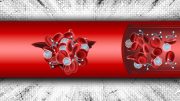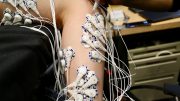
A team of biomedical engineers from Michigan Tech has created an affordable skin patch that alerts users when they should retreat from the sun in order to prevent sunburn.
A biomedical engineering design team from Michigan Tech has developed an inexpensive skin patch that warns the wearer when it’s time to get out of the sun to avoid getting sunburn.
By the time most of us realize we’ve been out in the sun too long, it’s too late. It can take up to 24 hours after exposure before you realize you have a sunburn.
Now, a Michigan Technological University Senior Design team has devised a sensor that tells you when it’s time to seek shelter, long before your skin gets red and tender.
The biomedical engineering seniors developed a skin patch imprinted with a graphic—in this case, a happy face design. The nickel-size patch gradually darkens under ultraviolet light, the type of light that causes sunburn and skin cancer. When you can’t see the happy face anymore, it’s time to get out of the sun.
Not everyone burns at the same rate, and the team took that into account. “We calibrated it based on skin type,” said team member Anne François. Their prototypes were made for the three skin types that are most susceptible to sunburn.
The patch is made with UV-sensitive film bonded to a special tape with medical-grade adhesive that can withstand plenty of trips into the swimming pool. Because it measures total UV exposure, it “knows” when a user applies sunscreen or goes in the shade and darkens more slowly.
The team has filed a provisional patent on their invention and received Best Overall Award in the Invention Disclosure Competition at Michigan Tech’s 2013 Undergraduate Expo. If it makes it to market, it would be inexpensive: the prototypes cost only 13 cents apiece in materials.
The UV monitors would be ideal for those wanting to avoid a sunburn and reduce their skin cancer risk while still enjoying outdoor activities, say the students. In addition, parents could use them to monitor their children’s UV exposure. The patches could be especially useful in protecting babies’ tender skin. They might even have some therapeutic applications for jaundiced babies, who need some sunlight—but not too much.
“There are other personal UV monitors out there, but what makes this one unique is that it’s extremely simple and inexpensive,” said the team’s co-advisor, Megan Frost, an assistant professor of biomedical engineering. “It’s not a timer. They quantitatively calibrated it to the energy the device absorbs, and it’s very robust.”
The project has been rewarding, says team member Caroline D’Ambrosio: “It’s great to actually make a working product.”
Other members of the Senior Design team are co-advisor Sean Kirkpatrick, Marie D’Ambrosio and Kelsey Sherman.









Be the first to comment on "Inexpensive Skin Patch Warns When It’s Time to Get Out of the Sun"